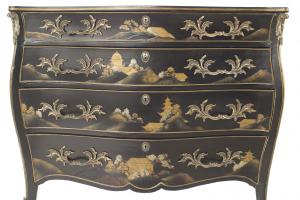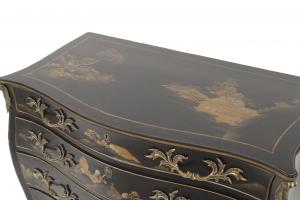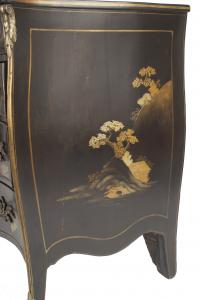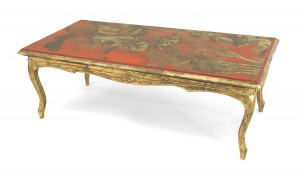X
{{ modalTitle }}
PLEASE FILL IN THE REQUIRED FIELDS.X
X
{{ modalTitle }}
Choose one of the options below.X
ITEM SUCCESSFULLY
ADDED TO PROJECT
French Louis XV Style Black Chinoiserie Commode
 French
French Louis XV
Louis XV Tables, Cabinets & Case Goods, Dining Room
Tables, Cabinets & Case Goods, Dining Room Console/Wall Tables, Dresser/Chests, Sideboards and Buffets
Console/Wall Tables, Dresser/Chests, Sideboards and Buffets
Newel Warehouse
32-00 Skillman Ave
Long Island City NY - 11101
 (212) 758-1970
(212) 758-1970
French Louis XV Style Black Chinoiserie Commode

Newel Warehouse
32-00 Skillman Ave
Long Island City NY - 11101
 (212) 758-1970
(212) 758-1970
 Tables, Cabinets & Case Goods, Dining Room
Tables, Cabinets & Case Goods, Dining Room Console/Wall Tables, Dresser/Chests, Sideboards and Buffets
Console/Wall Tables, Dresser/Chests, Sideboards and BuffetsLouis XV
Also known as Louis Quinze, was a style popularized by King Louis XV of France. The Sun King reigned in France between 1715 and 1774. The furniture style from this period is similar to Rococo with soft, flowing lines, shell and flower ornamentation, S-curves, rich padded upholstery, rare wood veneers, inlaying and painted furniture.
Bombé
Bombé is a French term that means “blown out”. Bombé is used to describe furniture with bulging convex sides. The large outward swelling curve makes bombé furniture easy to recognize. Traditionally, bombé furniture comes in the form of chests, commodes, and armoires.
Chinoiserie
Chinoiserie is the European adaptation of Oriental designs. Chinoiserie can be dated back to the beginning of the 17th Century French, Rococo and Regency periods. The term chinoiserie comes from the word “chinois” which is French for “Chinese”. Common chinoiserie prints and motifs include foo dogs, pagodas, nature scenes, and dragons.
Commode
French form mimicking an English chest-of-drawers, dating from the mid 17th-century and very popular in the 18th century. Fashion greatly determined variances in styles and decoration, but commodes generally are wider than they are tall.
Louis XV
Also known as Louis Quinze, was a style popularized by King Louis XV of France. The Sun King reigned in France between 1715 and 1774. The furniture style from this period is similar to Rococo with soft, flowing lines, shell and flower ornamentation, S-curves, rich padded upholstery, rare wood veneers, inlaying and painted furniture.
Bombé
Bombé is a French term that means “blown out”. Bombé is used to describe furniture with bulging convex sides. The large outward swelling curve makes bombé furniture easy to recognize. Traditionally, bombé furniture comes in the form of chests, commodes, and armoires.
Chinoiserie
Chinoiserie is the European adaptation of Oriental designs. Chinoiserie can be dated back to the beginning of the 17th Century French, Rococo and Regency periods. The term chinoiserie comes from the word “chinois” which is French for “Chinese”. Common chinoiserie prints and motifs include foo dogs, pagodas, nature scenes, and dragons.
Commode
French form mimicking an English chest-of-drawers, dating from the mid 17th-century and very popular in the 18th century. Fashion greatly determined variances in styles and decoration, but commodes generally are wider than they are tall.
Louis XV
Also known as Louis Quinze, was a style popularized by King Louis XV of France. The Sun King reigned in France between 1715 and 1774. The furniture style from this period is similar to Rococo with soft, flowing lines, shell and flower ornamentation, S-curves, rich padded upholstery, rare wood veneers, inlaying and painted furniture.
Bombé
Bombé is a French term that means “blown out”. Bombé is used to describe furniture with bulging convex sides. The large outward swelling curve makes bombé furniture easy to recognize. Traditionally, bombé furniture comes in the form of chests, commodes, and armoires.
Chinoiserie
Chinoiserie is the European adaptation of Oriental designs. Chinoiserie can be dated back to the beginning of the 17th Century French, Rococo and Regency periods. The term chinoiserie comes from the word “chinois” which is French for “Chinese”. Common chinoiserie prints and motifs include foo dogs, pagodas, nature scenes, and dragons.
Commode
French form mimicking an English chest-of-drawers, dating from the mid 17th-century and very popular in the 18th century. Fashion greatly determined variances in styles and decoration, but commodes generally are wider than they are tall.











